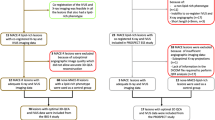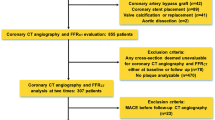Abstract
A beneficial surrogate marker for evaluating the effect of medical therapy is warranted to avoid deferred lesion revascularization. Similar to coronary artery imaging for monitoring the effects of medical therapy by analyzing plaque regression and stabilization, we hypothesized that evaluation of serial changes in the quantitative flow ratio (QFR) would serve as a surrogate marker of the effects of medical therapy against deferred lesion revascularization. Here, we investigated serial changes in QFR over time after percutaneous coronary intervention in patients who underwent medical therapy as a secondary prevention. Patients with intermediate stenosis in an untreated vessel observed at the baseline (BL) coronary angiography and follow-up (FU) coronary angiography performed 6–18 months after BL angiography were screened in 2 centers. A total of 52 patients were able to analyze both BL and FU QFR. The median QFR was 0.83 (IQR, 0.69, 0.89) at BL and 0.80 (IQR, 0.70, 0.86) at FU. The number of positive ΔQFR and negative ΔQFR were 21 and 31, respectively. The median ΔQFR was 0.05 (IQR, 0.03, 0.09) in positive ΔQFR and – 0.05 (IQR, – 0.07, – 0.03) in negative ΔQFR (p < 0.0001). Univariate and multivariate analyses revealed that LDL-C at FU predicted improvement in the QFR (OR 0.95, 95% confidence interval [0.91, 0.98], P = 0.001). Assessment of serial changes in the QFR may serve as a surrogate marker for the effects of medical therapy in patients with residual intermediate coronary stenosis.





Similar content being viewed by others
References
Götberg M, Christiansen EH, Gudmundsdottir IJ, Sandhall L, Danielewicz M, Jakobsen L, Olsson SE, Öhagen P, Olsson H, Omerovic E, Calais F, Lindroos P, Maeng M, Tödt T, Venetsanos D, James SK, Kåregren A, Nilsson M, Carlsson J, Hauer D, Jensen J, Karlsson AC, Panayi G, Erlinge D, Fröbert O (2017) Instantaneous wave-free ratio versus fractional flow reserve to guide PCI. N Engl J Med 376(19):1813–1823
Levine GN, Bates ER, Blankenship JC, Bailey SR, Bittl JA, Cercek B, Chambers CE, Ellis SG, Guyton RA, Hollenberg SM, Khot UN, Lange RA, Mauri L, Mehran R, Moussa ID, Mukherjee D, Nallamothu BK, Ting HH (2011) 2011 ACCF/AHA/SCAI Guideline for percutaneous coronary intervention. A report of the American college of cardiology foundation/American heart association task force on practice guidelines and the society for cardiovascular angiography and interventions. J Am Coll Cardiol 58(24):e44-122
Neumann FJ, Sousa-Uva M, Ahlsson A, Alfonso F, Banning AP, Benedetto U, Byrne RA, Collet JP, Falk V, Head SJ, Jüni P, Kastrati A, Koller A, Kristensen SD, Niebauer J, Richter DJ, Seferovic PM, Sibbing D, Stefanini GG, Windecker S, Yadav R, Zembala MO (2019) 2018 ESC/EACTS Guidelines on myocardial revascularization. Eur Heart J 40(2):87–165
Hirai K, Kawasaki T, Sakakura K, Soejima T, Kajiyama K, Fukami Y, Haraguchi K, Okonogi T, Fukuoka R, Orita Y, Umeji K, Koga H, Yamabe H (2020) Determinants of insufficient improvement in fractional flow reserve following percutaneous coronary intervention. Heart Vessels 35:1650–1656
Matsuo H, Kawase Y (2016) FFR and iFR guided percutaneous coronary intervention. Cardiovasc Interv Ther 31(3):183–195
Kuramitsu S, Matsuo H, Shinozaki T, Horie K, Takashima H, Terai H, Kikuta Y, Ishihara T, Saigusa T, Sakamoto T, Suematsu N, Shiono Y, Mizuno A, Tsujita K, Masamura K, Yokoi H, Tanaka N (2020) Two-year outcomes after deferral of revascularization based on fractional flow reserve: The J-CONFIRM registry. Circ Cardiovasc Interv 13(1):e008355
Nissen SE, Nicholls SJ, Sipahi I, Libby P, Raichlen JS, Ballantyne CM, Davignon J, Erbel R, Fruchart JC, Tardif JC, Schoenhagen P, Crowe T, Cain V, Wolski K, Goormastic M, Tuzcu EM (2006) Effect of very high-intensity statin therapy on regression of coronary atherosclerosis: the ASTEROID trial. JAMA 295(13):1556–1565
Okazaki S, Yokoyama T, Miyauchi K, Shimada K, Kurata T, Sato H, Daida H (2004) Early statin treatment in patients with acute coronary syndrome: demonstration of the beneficial effect on atherosclerotic lesions by serial volumetric intravascular ultrasound analysis during half a year after coronary event: the ESTABLISH Study. Circulation 110(9):1061–1068
Hiro T, Kimura T, Morimoto T, Miyauchi K, Nakagawa Y, Yamagishi M, Ozaki Y, Kimura K, Saito S, Yamaguchi T, Daida H, Matsuzaki M (2009) Effect of intensive statin therapy on regression of coronary atherosclerosis in patients with acute coronary syndrome: a multicenter randomized trial evaluated by volumetric intravascular ultrasound using pitavastatin versus atorvastatin (JAPAN-ACS [Japan assessment of pitavastatin and atorvastatin in acute coronary syndrome] study). J Am Coll Cardiol 54(4):293–302
Takayama T, Hiro T, Yamagishi M, Daida H, Hirayama A, Saito S, Yamaguchi T, Matsuzaki M (2009) Effect of rosuvastatin on coronary atheroma in stable coronary artery disease: multicenter coronary atherosclerosis study measuring effects of rosuvastatin using intravascular ultrasound in Japanese subjects (COSMOS). Circ J 73(11):2110–2117
Ballantyne CM, Raichlen JS, Nicholls SJ, Erbel R, Tardif JC, Brener SJ, Cain VA, Nissen SE (2008) Effect of rosuvastatin therapy on coronary artery stenoses assessed by quantitative coronary angiography: a study to evaluate the effect of rosuvastatin on intravascular ultrasound-derived coronary atheroma burden. Circulation 117(19):2458–2466
Komukai K, Kubo T, Kitabata H, Matsuo Y, Ozaki Y, Takarada S, Okumoto Y, Shiono Y, Orii M, Shimamura K, Ueno S, Yamano T, Tanimoto T, Ino Y, Yamaguchi T, Kumiko H, Tanaka A, Imanishi T, Akagi H, Akasaka T (2014) Effect of atorvastatin therapy on fibrous cap thickness in coronary atherosclerotic plaque as assessed by optical coherence tomography: the EASY-FIT study. J Am Coll Cardiol 64(21):2207–2217
Tu S, Barbato E, Köszegi Z, Yang J, Sun Z, Holm NR, Tar B, Li Y, Rusinaru D, Wijns W, Reiber JH (2014) Fractional flow reserve calculation from 3-dimensional quantitative coronary angiography and TIMI frame count: a fast computer model to quantify the functional significance of moderately obstructed coronary arteries. JACC Cardiovasc Interv 7(7):768–777
Tu S, Westra J, Yang J, von Birgelen C, Ferrara A, Pellicano M, Nef H, Tebaldi M, Murasato Y, Lansky A, Barbato E, van der Heijden LC, Reiber JHC, Holm NR, Wijns W (2016) Diagnostic accuracy of fast computational approaches to derive fractional flow reserve from diagnostic coronary angiography: the international multicenter favor Pilot study. JACC Cardiovasc Interv 9(19):2024–2035
Westra J, Andersen BK, Campo G, Matsuo H, Koltowski L, Eftekhari A, Liu T, Di Serafino L, Di Girolamo D, Escaned J, Nef H, Naber C, Barbierato M, Tu S, Neghabat O, Madsen M, Tebaldi M, Tanigaki T, Kochman J, Somi S, Esposito G, Mercone G, Mejia-Renteria H, Ronco F, Bøtker HE, Wijns W, Christiansen EH, Holm NR (2018) diagnostic performance of in-procedure angiography-derived quantitative flow reserve compared to pressure-derived fractional flow reserve: The FAVOR II Europe-Japan Study. J Am Heart Assoc 7(14):e009603
Westra J, Tu S, Winther S, Nissen L, Vestergaard MB, Andersen BK, Holck EN, Fox Maule C, Johansen JK, Andreasen LN, Simonsen JK, Zhang Y, Kristensen SD, Maeng M, Kaltoft A, Terkelsen CJ, Krusell LR, Jakobsen L, Reiber JHC, Lassen JF, Bøttcher M, Bøtker HE, Christiansen EH, Holm NR (2018) Evaluation of coronary artery stenosis by quantitative flow ratio during invasive coronary angiography: The WIFI II Study (Wire-Free Functional Imaging II). Circ Cardiovasc Imaging 11(3):e007107
Suzuki N, Nishide S, Kimura T, Kimura T, Aoyagi T, Kanamori K, Shiratori Y, Hayami N, Murakawa Y, Kozuma K (2020) Relationship of quantitative flow ratio after second-generation drug-eluting stent implantation to clinical outcomes. Heart Vessels 35:743–749
Teramoto T, Sasaki J, Ishibashi S, Birou S, Daida H, Dohi S, Egusa G, Hiro T, Hirobe K, Iida M, Kihara S, Kinoshita M, Maruyama C, Ohta T, Okamura T, Yamashita S, Yokode M, Yokote K (2013) Executive summary of the Japan Atherosclerosis Society (JAS) guidelines for the diagnosis and prevention of atherosclerotic cardiovascular diseases in Japan -2012 version. J Atheroscler Thromb 20(6):517–523
JCS (2013) Guidelines for the management of patients with ST-elevation acute myocardial infarction (Japanese Circulation Society 2013). http://wwwj-circ.orjp/guideline/pdf/JCS2013_kimura_h.pdf Accessed March 1st 2021
Amano H, Noike R, Yabe T, Watanabe I, Okubo R, Koizumi M, Toda M, Ikeda T (2020) Fraility and coronary plaque characteristics on optical coherence tomography. Heart Vessels 35:750–761
Hashikata T, Tojo T, Muramatsu Y, Sato T, Kakizaki R, Nemoto T, Fujiyoshi K, Namba S, Kitasato L, Hashimoto T, Kameda R, Shimohama T, Yamaoka-Tojo M, Ako J (2018) Lower level of low density lipoprotein cholesterol is associated with a higher increase in the fractional flow reserve in patients with fixed-dose rosuvastatin. J Atheroscler Thromb 25(3):233–243
Kuramitsu S, Sonoda S, Ando K, Otake H, Natsuaki M, Anai R, Honda Y, Kadota K, Kobayashi Y, Kimura T (2021) Drug-eluting stent thrombosis: current and future perspectives. Cardiovasc Interv Ther 36(2):158–168
Varenne O, Cook S, Sideris G, Kedev S, Cuisset T, Carrié D, Hovasse T, Garot P, El Mahmoud R, Spaulding C, Helft G, Diaz Fernandez JF, Brugaletta S, Pinar-Bermudez E, Mauri Ferre J, Commeau P, Teiger E, Bogaerts K, Sabate M, Morice MC, Sinnaeve PR (2018) Drug-eluting stents in elderly patients with coronary artery disease (SENIOR): a randomised single-blind trial. Lancet 391(10115):41–50
Varenhorst C, Lindholm M, Sarno G, Olivecrona G, Jensen U, Nilsson J, Carlsson J, James S, Lagerqvist B (2018) Stent thrombosis rates the first year and beyond with new- and old-generation drug-eluting stents compared to bare metal stents. Clin Res Cardiol 107(9):816–823
Shiomi H, Morimoto T, Kitaguchi S, Nakagawa Y, Ishii K, Haruna Y, Takamisawa I, Motooka M, Nakao K, Matsuda S, Mimoto S, Aoyama Y, Takeda T, Murata K, Akao M, Inada T, Eizawa H, Hyakuna E, Awano K, Shirotani M, Furukawa Y, Kadota K, Miyauchi K, Tanaka M, Noguchi Y, Nakamura S, Yasuda S, Miyazaki S, Daida H, Kimura K, Ikari Y, Hirayama H, Sumiyoshi T, Kimura T (2017) The ReACT Trial: randomized evaluation of routine follow-up coronary angiography after percutaneous coronary intervention trial. JACC Cardiovasc Interv 10(2):109–117
Collet C, Katagiri Y, Miyazaki Y, Asano T, Sonck J, van Geuns RJ, Andreini D, Bittencourt MS, Kitslaar P, Tenekeciouglu E, Tijssen JGP, Piek JJ, de Winter RJ, Cosyns B, Rogers C, Zarins CK, Taylor C, Onuma Y, Serruys PW (2018) Impact of coronary remodeling on fractional flow reserve. Circulation 137(7):747–749
Guethlin M, Kasel AM, Coppenrath K, Ziegler S, Delius W, Schwaiger M (1999) Delayed response of myocardial flow reserve to lipid-lowering therapy with fluvastatin. Circulation 99(4):475–481
Baller D, Notohamiprodjo G, Gleichmann U, Holzinger J, Weise R, Lehmann J (1999) Improvement in coronary flow reserve determined by positron emission tomography after 6 months of cholesterol-lowering therapy in patients with early stages of coronary atherosclerosis. Circulation 99(22):2871–2875
Layland J, Carrick D, McEntegart M, Ahmed N, Payne A, McClure J, Sood A, McGeoch R, MacIsaac A, Whitbourn R, Wilson A, Oldroyd K, Berry C (2013) Vasodilatory capacity of the coronary microcirculation is preserved in selected patients with non-ST-segment-elevation myocardial infarction. Circ Cardiovasc Interv 6(3):231–236
Author information
Authors and Affiliations
Corresponding author
Ethics declarations
Conflict of interest
This study was supported by JSPS KAKENHI Grant Number JP17K09504.
Additional information
Publisher's Note
Springer Nature remains neutral with regard to jurisdictional claims in published maps and institutional affiliations.
Rights and permissions
About this article
Cite this article
Takenaka, H., Okamura, T., Miyazaki, Y. et al. Serial changes in the quantitative flow ratio in patients with intermediate residual stenosis after percutaneous coronary intervention. Heart Vessels 37, 363–373 (2022). https://doi.org/10.1007/s00380-021-01923-x
Received:
Accepted:
Published:
Issue Date:
DOI: https://doi.org/10.1007/s00380-021-01923-x




